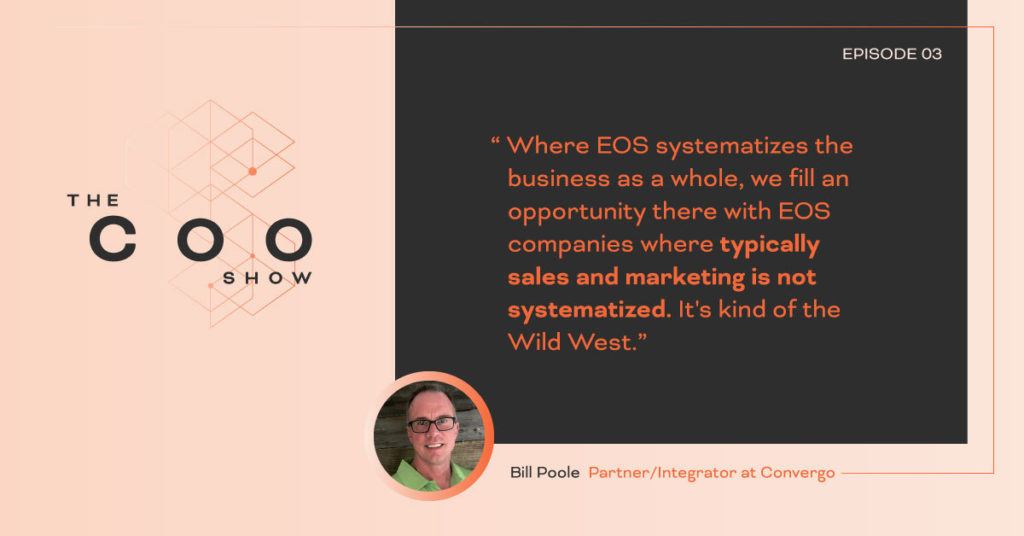
by Bill Poole | Jul 28, 2022 | Strategy
Sales and marketing are historically misaligned, which is very curious given their goals are really the same, right? If sales and marketing both have the same goal of bringing more clients into the business, it doesn’t make sense that this misalignment still occurs. And technology and communication have evolved to the point that this misalignment should no longer be acceptable. So how can you bridge this misalignment? Here are four strategies for aligning sales and marketing:
- Track the right scorecard metrics
- Develop an aligned messaging plan
- Create cross-functional processes
- Align your tech and data
Let’s look at each one of the 4 strategies to align sales and marketing from a before and after perspective:
- Before: Sales and marketing exist as foes in silos
- After: Sales and marketing are aligned and working together to bring on more clients and sell more to their clients.
One point to reinforce, as we always do at Convergo, is that businesses should be focused on acquiring and retaining ideal clients, not just any client. Ideal Clients are the ones that can buy everything that you sell and that your business is optimized to serve. That concept is woven throughout this blog.

Track the Right Scorecard Metrics
Before: Sales and marketing have their own metrics that are completely unrelated. Marketing is pursuing scorecard metrics like website traffic or # of leads. In the meantime, sales managers hammer their sales teams to do more demos or deliver more proposals. What is missing from these metrics? Remember the Ideal Client concept?
After: Website traffic and number of leads are put by the wayside because they don’t consider the ideal client.
An Alternative metric is # of Ideal Prospect leads. This is the number of leads that come in that meet the Ideal Client Profile (ICP) criteria.
How does this promote alignment? First, marketing and sales agree on the ICP, and leads are filtered against this. Marketing then focuses its efforts on generating the right leads, and sales prioritizes closing them instead of chasing their tails with clients that are not necessarily good for the business. By the way, it is much easier for marketing to have a more narrow focus, and it takes fewer sales reps to close ideal clients and filter out suboptimal ones.
Develop An Aligned Messaging Plan
Before: Marketing is creating content and executing a plan that is based on their assumptions about a fictional persona that they assume is correct because they get no feedback from the sales team on what real people are saying.Meanwhile, the sales team complains that the marketing team is passing along leads that are not closable. They get frustrated, and the two sides maintain life in their silos.
After: The content plan is based on an Ideal Client Profile with personas created and agreed upon by both sales and marketing. Sales and Marketing have regular meetings where the sales team shares common questions, concerns, and outcomes that their clients and prospects are asking about and sharing.
Then, the content hits the mark, and sales reps have begun actively sharing content to support their efforts to serve their prospects and clients.
Create Cross-Functional Processes
Before: Marketing has their processes to create content and tactics to increase website traffic and generate “leads, ” which have a very low close rate. In their mind, they are succeeding because all that they are being asked to do is to generate leads.
Sales teams are managing their sales process. A low percentage of leads are actually sales qualified, and even fewer advance to later stages in the sales cycle.
After: The “Sales Cycle” has been replaced by a “Net-New Experience” where sales and marketing work together to bring the Ideal Clients into their business and usher out the ones that are not good fits.
Only Ideal Prospects are in the pipeline, and sales reps help them through the Net-New Experience using documented processes supported by marketing content that answers their questions, generates trust, and helps them seamlessly navigate the experience with your business.
Align Your Tech and Data
Before: Marketing uses platforms to execute tactics like email marketing and may have access to databases of companies in their market that might fit their profile. A lead is created and passed off to sales, often with limited information.
Sales uses their “CRM” for their sales process to close business. They don’t have visibility to what content the prospect might engage with and therefore are serving the prospect only knowing part of the picture.
In the meantime, client data is trapped inside a proprietary ERP that sales has no visibility to, limiting potential cross-selling possibilities.
After: The CRM is a single source of the truth, with Marketing, Sales, and Operations enjoying a 360-degree view of the Ideal Prospect/Client from when the prospect is totally unaware of your business to where they are buying everything they can from you.
Conclusion
Given advancements in CRM and Marketing Automation from companies like Hubspot, the excuses for Sales and marketing working in silos are disappearing. Stay tuned for more detail on each of these 4 strategies in separate blogs.

by Bill Poole | Jun 27, 2022 | Strategy
When it comes to content most sales and marketing teams spend time asking the question, “What content should we present?” They should also be considering this: “When during the sales cycle should we present specific content?”
Today’s buyers are overwhelmed with information. Over the past decade, the focus on content marketing has created an incredible volume of (mostly) useful information. (A recent Gartner survey of 1,000 B2B customers showed that buyers felt about 90% of information they encountered as part of a purchase is high quality.)
In the January 2022 edition of the Harvard Business Review, co-author of The Challenger Sale, Brent Adamson, makes that case that in the world of easy access to information, the job of sales is to help prospects make sense of all the information. He calls this sales role, “sensemaking.”
One way you can help your buyers make sense of their decision is by sharing the right information at the right time during the sales cycle.
Adamson says, “Reps must carefully consider what information to disclose when, how to present it, and—most important—how to connect it to everything else the customer is learning.” The goal is to make sure the seller is seen as both proactive and objective as they help the buyer make sense of their choices.
In a world of complex decisions where the biggest competitor is often the status quo, presenting the right information at the right time is a critical part of an effective revenue growth strategy. Again posing the question, “how you can share the right information at the right time?”
Here are three steps to help you know when to share information.
Understand The Stages of Your Client Experience
While salespeople like to think of a sales cycle, the real party in control is the buyer. You could consider their buying cycle. Since most companies have long term relationships with their buyers that go on long after the initial purchase, I like to consider the entire client experience. (And, since growth happens best with Ideal Clients, I like to look at the client experience through the eyes of an ideal client. We call this the Ideal Client Experience.)
During a Revenue Growth Workshop, we help clients map out the stages of their Ideal Client Experience. At each stage we consider the motivation to move forward and the friction that might hold the buyer back. These two categories help define the content that could be helpful at each stage.
Create a Focused Message Plan
Next, you need to create a Focused Message Plan. In Revenue Growth Engine, I talk about the reality that buyers don’t buy products and services, they buy the outcomes the products and services enable. Thus, your content should be focused on the outcomes your client wants.

You can take this concept to each stage of your Ideal Client Experience. What are the outcomes your client wants at each stage? What questions do they want answered? Where do they want clarity?
In a Focused Message Plan, content is strategically created to address the motivation and friction at each stage of the Ideal Client Experience. By addressing questions and introducing helpful insights at the right time, content helps move deals forward faster, creating pipeline velocity.
Integrate Content Into Your Playbooks
Mapping your Ideal Client Experience and creating a Focused Message Plan are useless if they don’t get integrated into your sales practices and culture. The final stage involves creating playbooks for each stage of your Ideal Client Experience. In addition to documenting the process, identifying tools, and creating training for each stage, effective playbooks also contain content suggestions. Sales reps become armed with the right content to share at the right time.
Best of all, the well-timed content can be shared proactively during the sales process. This helps build the trust necessary to close the deal.
Action Items
Have you identified your Ideal Client, mapped out your Ideal Client Experience, created a Focused Message Plan, and integrated this into your Revenue Growth Playbooks? If not, that is a great way to begin. Schedule your Explore Meeting now to learn more about how other companies are using these strategies to accelerate growth.

Sources:
Brent Adamson, Harvard Business Review: https://hbr.org/2022/01/sensemaking-for-sales
![[Podcast] Systematizing Sales & Marketing w/ EOS® Strategies](https://www.convergo.co/wp-content/uploads/2022/06/jonathan-velasquez-c1ZN57GfDB0-unsplash-1080x675.jpg)
by Bill Poole | Jun 15, 2022 | Strategy
Bill Poole was a guest on The COO Show where he chatted with host Bill Reed about why there may be silos in your organization and how to integrate your teams to drive revenue growth. They also talked about how important change management is for creating lasting change and happier employees. Listen to the episode below!

Read the article here.

by Bill Poole | May 31, 2022 | Strategy
What if the way we think about Buyer’s Journey is upside down?
Smart marketing and sales teams collaborate to map out the buyer’s journey, thinking about how they can provide the right information to buyers at the right time during their decision making process. While this sounds helpful, I see a few problems:
First, the Buyer’s Journey is anything but linear. In most cases, it looks more like a cloud of dust than a straight line. Trying to determine where a buyer is in this process feels futile, yet sales and marketing teams try to plot this out. It’s no wonder that most Buyer’s Journey maps get created and then rarely used.
Second, and perhaps most importantly, buyers buy based on emotion more than fact. Harvard professor emeritus and author of How Customer’s Think, Gerald Zaltman, shares research that validates what I’ve learned in every sales training over the past three decades of my career: “Emotion is what really drives the purchasing behaviors, and also, decision making in general.” He found that 95% of purchasing decisions are subconscious [Source].
In his book, The Perfect Plan, Don Barden cites data that buyers only remember a tiny fraction of the knowledge you share with them. They all remember how you make them feel. In essence, the buying process should be designed less to make the buyer an expert in your area of speciality, and more to make them feel comfortable that you can help them achieve results.
On the other side of the buying process, we have this thing called Customer Experience. Once a new customer signs the order, the CX team kicks into action. Smart companies look at the experience across the customer lifecycle, strategically building emotions that sustain loyalty.
An entire genre of work around CX exists in the operations and customer success world by authors like Joseph Pine, James Gilmore, and Joey Coleman to name a few. Most of this research has yet to make its way into net-new sales and marketing.
Buyers buy based on emotion. They use facts to feel confident (emotion) and reduce fear (emotion) about their decision.
Based on this line of thinking, here are a few questions:
- Since buyers buy off emotion, what if we took the lessons of Customer Experience and applied them to the Buyer’s Journey?
- What if the buyer’s journey was as focused on how we made the members of the buying team feel rather than just trying to arm them with knowledge?
- How could this transform marketing and sales?
- How could marketing and sales cooperate to create a memorable and meaningful Buyer’s Experience?
- What if we replaced the term Buyer’s Journey with Buyer’s Experience?
Originally published on Darrell Amy’s LinkedIn.

by Bill Poole | Apr 18, 2022 | Strategy
The past two years have been incredibly challenging. Hats off to all of the teams that have pivoted, re-pivoted, and adapted to survive the COVID-19 pandemic. To say it has been incredibly challenging is an understatement.
As we emerge from the pandemic, we find ourselves in the midst of new challenges. Global instability, energy costs, and rising interest rates all lead to inflation. The supply chain crisis continues to pose problems. The tight labor force and high turnover definitely makes things hard. As usual, there are many business issues to address.
Here is what I see as the problem. The shocking nature of the pandemic with all of its unknowns, lockdowns, and related fear put most companies in survival mode.
Teams focused on how to keep customers rather than go for new ones. This made sense. In some companies, it even caused them to realize that they need to take better care of their clients. However, many of the plans for growth were scuttled in favor of survival.
We cannot stay in survival mode forever.
The temptation in this current economic environment is to stay in survival mode. After all, things are hard.
“Grow or die” is a core value of EOS Worldwide. I love this! (I’m looking forward to presenting at their conference next week in Orlando!) There is a lot of truth to this. Companies that are not growing are dying.
We must continue to grow. We must get out of survival mode.
How can we shift from survival mode back to growth mode?
Recast Growth Goals
Are your revenue growth goals grounded in reality? My experience is that most companies set goals in one of two ways. Neither are helpful.
First, there is the all-too-common spaghetti-on-the-wall method. “What do you think we can do?” Of course, visionaries like me throw the spaghetti high up the wall. More conservative integrators like to throw the spaghetti right above the baseboard. Somehow we compromise in the middle. The problem is that the goal is not realistic.
Others set goals based on the ruler method, lining up the growth trend over the past few years. The problem is that the past few years have been anything but normal.
Instead, I recommend setting growth goals based on the two drivers of growth: Net-New and Cross-Sell. For net-new, the metric is how many customers we have. The goal is how many customers could we add. For cross-sell, the metric is our current revenue per client? The goal is how much could we increase the revenue per client with the right plan and playbooks in place? Multiply your number of clients goal by your revenue per client goal and you have what I call an ABR (Aggressive But Realistic) revenue goal.

Reconsider Customer Expectations
As the business environment shifts, customer expectations have shifted. What delighted customers in 2019 may not work as well in 2022. “But Darrell,” you say, “We are still committed to the same values and excellent customer service.” Sure, but the way those values and service expectations are delivered to your customers may need to shift.
Looking at your customer experience can help. How can you see the needs of your customers through their eyes? If you did, what would need to change?
During Revenue Growth Workshops we map out the Ideal Client Experience. Marketing, sales, and operations get on the same page with what happens from the time a prospect first encounters the company all the way through their experience as a client. This exercise is very helpful to do in light of new expectations and hybrid work environments.
Recreate Your Plan
With your goals and client experience in mind it’s time to create a plan. This plan needs to align marketing, sales, and operations around your growth goals. What needs to be optimized? What’s missing? How can you do things to account for your current work structure and your clients’ expectations?
Revisit Your Playbooks
I love going to my granddaughter’s sports games. Both of them are under the age of 10 and relatively new to team sports. Whether they are playing basketball or soccer, they have one thing in common. The entire team runs to the ball. A giant horde of kids surround the ball. This amorphous mass of humanity suffocates the game. There is no way to pass the ball. As a result, the score is usually very low.
What’s wrong with this picture? While we of course give grace to these cute kids, the reality is that they don’t have a playbook. Everyone is just doing their own thing. The result is chaos.
What about your marketing, sales, and operations team? Do they have a playbook?
If you have revenue playbooks, it’s time to revisit them in light of the new environment. If you don’t have revenue playbooks, its time to create them!
A revenue playbook ensures that marketing, sales, and operations are working in concert to maximize both net-new and cross-sell revenue. Revenue playbooks give everyone a clear understanding of the ideal clients, personas, client experience, and processes. The include tools and content.
The result of a playbook is consistency.

by Bill Poole | Mar 23, 2022 | Strategy
Series: How To Make Revenue Growth Predictable In Uncertain Times
Part 1
Part 2 (this article)
Part 3
Over the past few years business leaders have become familiar with uncertainty. In the midst of pandemic pivots, supply-chain shifts, and hiring hassles, one thing has remained constant: the need for revenue.
Revenue is the lifeblood of business. We have proven our ability to solve all kinds of problems, but revenue problems are a massive change. Some of the biggest problems happen when uncertainty leads to unpredictable revenue. Thus, it is important to take smart actions to ensure revenue growth remains predictable, especially in uncertain times.
This is the second in a series of three articles offering strategies to make revenue growth predictable. Previously we explored the importance of Focusing Your Message. In this article we will unpack the second strategy: aligning marketing, sales, and operations around your Client Experience.
(In this article, I will use the words client and customer interchangeably. Some industries have customers while others have clients. Personally, I like the word client, even in an industry that traditionally uses the word customer because the world client infers a relationship of trust.)
What Is Client Experience?
Client Experience is the sum total of the impressions and feelings your prospects and clients have as they interact with your company.
My first employer, Lanier Worldwide, had a great company tagline, Customer Vision. They defined it as follows: “We strive to see your business and your needs through your eyes.” This is the mindset of Client Experience.
Marketing, sales, and operations teams tend to look at things through their own lenses. Marketing sees audiences, funnels, and leads. Sales sees activity, pipeline, and deals. Operations sees processes, support desks, and NPS (Net Promoter Score) rankings. It’s no wonder that these teams have trouble communicating, even in small companies that aren’t supposed to have silos.
A Client Experience perspective allows marketing, sales, and operations to look through the same lens. Seeing through the eyes of the customer (and prospective customer) they are able to understand what it might be like to interact with the company.
From this perspective, each team can then begin to think how they can enhance the entire experience. From there, playbooks can be created that orchestrate an amazing experience as marketing, sales, and operations work together to serve prospects and clients.
How Does Client Experience Help Make Revenue Predictable?
Improving Customer Experience leads to more predictable revenue in the following ways.
1. Maximize Cross-Sell Revenue
There are only two ways to grow revenue: grow net-new business by adding new customers or cross-sell more to your existing customers. For most companies the low-hanging fruit is in the cross-sell revenue.
Sadly, most companies fail to maximize their cross-sell revenue. Sales and marketing are focused on driving net-new. Once a customer comes on board they get handed off to operations or customer success. At that point, the marketing and selling stops. Marketing and sales move on to the next deal. Meanwhile, your base of clients desire multiple outcomes that your company could satisfy—if only they knew.
Looking at your Customer Experience shines a bright light on the areas where you could incorporate cross-sell strategies. Companies that get smart and consistent about about cross-sell build processes and playbooks to ensure they maximize their revenue-per-client.

2. Increase Client Retention
Employee turnover is a huge challenge. Client turnover is a problem as well. If you bring on 100 clients and lose 80, you are only up 20 clients. Even worse, you lost the potential to cross-sell to the 80 you lost. Focusing on Client Experience ensures that you minimize turnover, creating sustainable revenue.
3. Improve Customer Service
When everyone at your company understands the stages of the Customer Experience it begins to empower them to deliver better customer service. Without an understanding of the entire journey a prospect and customer have taken, individual employees are only making guesses about what they need to do. Good intentions may lead to actions that actually harm your Customer Experience. By mapping the entire experience and seeing it through the eyes of the customer you can come up with ways to improve your customer service.
4. Get More Referrals
Happy clients lead to referrals. Every sales rep knows that referrals have a high probability of closing. When you craft an engaging Customer Experience, you ensure that your sales team interacts with the customer after the initial sale. These interactions create the opportunity to ask for referrals.
5. Streamline Onboarding
We’ve all felt the cringe factor of a new employee interacting with a customer in a way that is counterproductive. Of course, we coach the employee to improve. Instead, what if new employees were able to see the entire Customer Experience through the eyes of an actual customer? They could review playbooks for each stage of the experience that explained the goals of the stage, the processes, the resources, and how their role fit into the overall experience. Mapping Customer Experience and then creating playbooks helps new team members feel comfortable in their role and assists them in getting up to speed as quickly as possible.
6. Allow Adaptability
Pivot could easily have been the word of the year for 2020. Companies that were able to adapt during the turbulent times of the pandemic were able to survive and thrive. When you have mapped out your Customer Experience you are able to adjust when the market shifts. These adjustments can be incorporated into modified playbooks when then filter down through your team. The end result is faster pivots.
All of these factors work together to to make revenue more predictable. During uncertain times this predictability is more important than ever.
Continue reading part 3 in the series of How to Make Revenue Predictable in Uncertain Times.






![[Podcast] Systematizing Sales & Marketing w/ EOS® Strategies](https://www.convergo.co/wp-content/uploads/2022/06/jonathan-velasquez-c1ZN57GfDB0-unsplash-1080x675.jpg)





